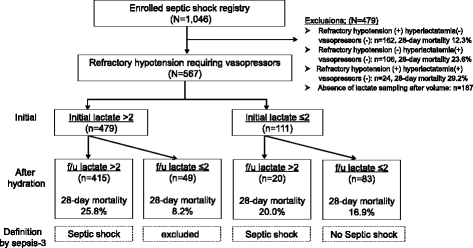Prognosis of patients excluded by the definition of septic shock based on their lactate levels after initial fluid resuscitation: a prospective multi-center observational study
- PMID: 29475445
- PMCID: PMC6389162
- DOI: 10.1186/s13054-017-1935-3
Prognosis of patients excluded by the definition of septic shock based on their lactate levels after initial fluid resuscitation: a prospective multi-center observational study
Abstract
Background: Septic shock can be defined both by the presence of hyperlactatemia and need of vasopressors. Lactate levels should be measured after volume resuscitation (as per the Sepsis-3 definition). However, currently, no studies have evaluated patients who have been excluded by the new criteria for septic shock. The aim of this study was to determine the clinical characteristics and prognosis of these patients, based on their lactate levels after initial fluid resuscitation.
Methods: This observational study was performed using a prospective, multi-center registry of septic shock, with the participation of 10 hospitals in the Korean Shock Society, between October 2015 and February 2017. We compared the 28-day mortality between patients who were excluded from the new definition (defined as lactate level <2 mmol/L after volume resuscitation) and those who were not (≥2 mmol/L after volume resuscitation), from among a cohort of patients with refractory hypotension, and requiring the use of vasopressors. Other outcome variables such as in-hospital mortality, intensive care unit (ICU) stay (days), Sequential Organ Failure Assessment (SOFA) scores and Acute Physiology and Chronic Health Evaluation (APACHE) II scores were also analyzed.
Results: Of 567 patients with refractory hypotension, requiring the use of vasopressors, 435 had elevated lactate levels, while 83 did not have elevated lactate levels (either initially or after volume resuscitation), and 49 (8.2%) had elevated lactate levels initially, which normalized after fluid resuscitation. Thus, these 49 patients were excluded by the new definition of septic shock. These patients, in whom perfusion was restored, demonstrated significantly lower age, platelet count, and initial and subsequent lactate levels (all p < 0.01). Similarly, significantly lower 28-day mortality was observed in these patients than in those who had not been excluded (8.2% vs 25.5%, p = 0.02). In-hospital mortality and the maximum SOFA score were also significantly lower in the excluded patients group (p = 0.03, both).
Conclusions: It seems reasonable for septic shock to be defined by the lactate levels after volume resuscitation. However, owing to the small number of patients in whom lactate levels were improved, further study is warranted.
Keywords: Emergency department; Lactate; Perfusion; Septic shock.
Conflict of interest statement
Ethics approval and consent to participate
The institutional review board of each institution approved the study protocol and informed consent was obtained before data collection.
Consent for publication
Not applicable.
Competing interests
The authors declare that they have no competing interests.
Publisher’s Note
Springer Nature remains neutral with regard to jurisdictional claims in published maps and institutional affiliations.
Similar articles
-
Effect of a Resuscitation Strategy Targeting Peripheral Perfusion Status vs Serum Lactate Levels on 28-Day Mortality Among Patients With Septic Shock: The ANDROMEDA-SHOCK Randomized Clinical Trial.JAMA. 2019 Feb 19;321(7):654-664. doi: 10.1001/jama.2019.0071. JAMA. 2019. PMID: 30772908 Free PMC article. Clinical Trial.
-
[The significance of lactic acid in early diagnosis and goal-directed therapy of septic shock patients].Zhonghua Wei Zhong Bing Ji Jiu Yi Xue. 2014 Jan;26(1):51-5. Zhonghua Wei Zhong Bing Ji Jiu Yi Xue. 2014. PMID: 24649525 Clinical Trial. Chinese.
-
[Prognostic value of arterial lactate combined with central venous-to-arterial carbon dioxide difference to arterial-to-central venous oxygen content difference ratio in septic shock patients].Zhonghua Wei Zhong Bing Ji Jiu Yi Xue. 2020 Jan;32(1):39-43. doi: 10.3760/cma.j.cn121430-20191226-00007. Zhonghua Wei Zhong Bing Ji Jiu Yi Xue. 2020. PMID: 32148229 Chinese.
-
[Updated definition of sepsis : Implications for diagnostics and therapy principles].Chirurg. 2017 Jan;88(1):81-92. doi: 10.1007/s00104-016-0330-y. Chirurg. 2017. PMID: 27975124 Review. German.
-
Relative efficacy and safety of early lactate clearance-guided therapy resuscitation in patients with sepsis: A meta-analysis.Medicine (Baltimore). 2019 Feb;98(8):e14453. doi: 10.1097/MD.0000000000014453. Medicine (Baltimore). 2019. PMID: 30813144 Free PMC article. Review.
Cited by
-
Evaluating the diagnostic performance of adult sepsis event criteria in the emergency department: impact of including isolated serum lactate elevations.J Intensive Care. 2025 Aug 15;13(1):44. doi: 10.1186/s40560-025-00815-w. J Intensive Care. 2025. PMID: 40817240 Free PMC article.
-
Mortality among adult patients with sepsis and septic shock in Korea: a systematic review and meta-analysis.Clin Exp Emerg Med. 2023 Jun;10(2):157-171. doi: 10.15441/ceem.23.005. Epub 2023 Mar 7. Clin Exp Emerg Med. 2023. PMID: 36882054 Free PMC article.
-
Early Vitamin C and Thiamine Administration to Patients with Septic Shock in Emergency Departments: Propensity Score-Based Analysis of a Before-and-After Cohort Study.J Clin Med. 2019 Jan 16;8(1):102. doi: 10.3390/jcm8010102. J Clin Med. 2019. PMID: 30654592 Free PMC article.
-
Pulse pressure during the initial resuscitative period in patients with septic shock treated with a protocol-driven resuscitation bundle therapy.Korean J Intern Med. 2021 Jul;36(4):924-931. doi: 10.3904/kjim.2020.056. Epub 2020 Aug 20. Korean J Intern Med. 2021. PMID: 32811131 Free PMC article.
-
Development of a Nomogram for Predicting Mortality Risk in Sepsis Patients During Hospitalization: A Retrospective Study.Infect Drug Resist. 2023 Apr 19;16:2311-2320. doi: 10.2147/IDR.S407202. eCollection 2023. Infect Drug Resist. 2023. PMID: 37155474 Free PMC article.
References
-
- Torio CM, Andrews RM. National inpatient hospital costs: the most expensive conditions by payer, 2011: statistical brief #160. In: Healthcare Cost and Utilization Project (HCUP) statistical briefs [Internet]. Edited by Agency for Healthcare Research and Quality. Agency for Healthcare Research and Quality: Rockville; 2013.
-
- Shankar-Hari M, Phillips GS, Levy ML, Seymour CW, Liu VX, Deutschman CS, Angus DC, Rubenfeld GD, Singer M, Sepsis Definitions Task F Developing a new definition and assessing new clinical criteria for septic shock: for the third international consensus definitions for sepsis and septic shock (Sepsis-3) JAMA. 2016;315(8):775–87. doi: 10.1001/jama.2016.0289. - DOI - PMC - PubMed
Publication types
MeSH terms
Substances
LinkOut - more resources
Full Text Sources
Other Literature Sources


